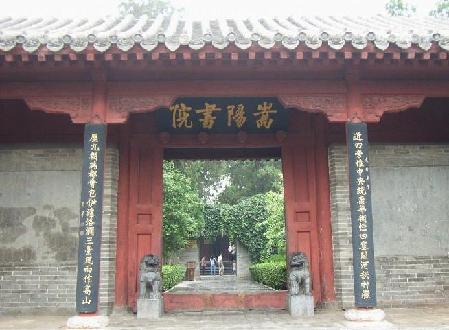The center of heaven and earth
As the plane is square, the observatory has smaller upper part and larger lower part, and is 12.62m in overall height. At the north of it are designed with two symmetrical step entrances for observation. The center of the northern wall is built into a hollow groove that is perforated through from top to bottom, so the higher gnomon at the groove’s straight wall and the stone gnomon at the bottom constitute a series of gnomon apparatus for measuring the length of shadow cast by the sun. The stone gnomon at the bottom of the groove is connected with 36 blocks of blue stone from south to north, and is 31.2m in length and 0.53m in width. The gnomon is carved with two parallel two-way watercourses. To the south of the watercourses is a suction sump, and to the north a discharge sump. Each sump has scales for measuring the levelness.
Songyang Academy of classical learning
Songyang Academy is located at the south foot of the Songshan Mountain, 3 kilometers north of Dengfeng County seat. Embraced by hills to the east and west, Songyang Academy enjoys a beautiful view with two brisk clear springs joining in front of it into a river and fertile fields extending far away to the south. Standing at the academy gate, visitors can see all the peaks of the Songshan Mountain and overlook the Dengfeng County seat. Being an ideal place for study, it is laurelled as one of the Four Academies of the Song Dynasty (960 – 1729 A.D.), together with the Suiyang Academy in Suizhou (also named “Yingtian Academy”), the Yuelu Adacemy in the Hunan Province and the Bailudong Adademy in Jiangxi Province.
 |
In history, Songyang Academy was jointly dominated by Buddhism and Daoism at first, later by the Confucianism exclusively. During the ages from the Later Zhou Dynasty (951 – 959 A.D.) of the Five Dynasties Period (907 – 959 A.D.) to the Song Dynasty (960 – 1279 A.D.), Chenghao and Cheng Xi, two great masters of the Luo School of the Confucianism, spread their theories here with hundreds of students. First built in 484 A.D., it had been remedied and extended for several times in different dynasties, later developed into an academy of a large scale with an air of simplicity and elegance.
















